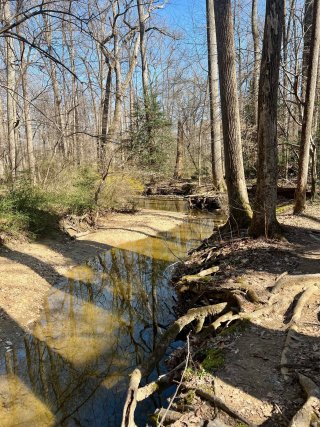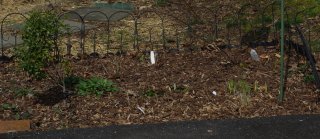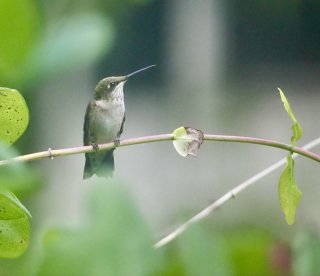Acting Upstream for Creek and Community
Taking a breath of fresh air, I walk along the babbling creek in my suburban neighborhood in Northern Virginia, listening to calls of birds and insects. On a warm spring afternoon, you can see foxes, deer, hawks, and woodpeckers flitting about the forest. I have gone on countless walks along this creek, either with family or seeking solitude, crossing the creek to go to school or strolling along in leisure.
Over the years, the walk has become more precarious as steep riverbanks have grown fragile and now appear as if they could collapse at any moment.

A common threat to streams like the one in my neighborhood is runoff from heavy rains that cause floods, wearing away at riverbanks. They can also carry pollutants, such as fertilizer and pesticides from yards, downstream.
I often see one of my neighbors, Barbara, walking near the creek. She agrees that runoff and erosion are severe in the park. “There are places you have to kind of wonder if you can safely cross on the bank.” Barbara continues, “We have to address the cause at its source, runoff from nearby yards.”
One way to do this is by growing plants that soak up the rain before it flows to the creek in areas outside the creek channel—an area known as the creek’s “watershed.” This natural solution for limiting runoff is
a management method known as bioretention, a type of green infrastructure.
Green infrastructure is used in urban areas to restore the water cycle by soaking up excess stormwater and reducing flooding downstream. It uses nature to protect habitat and local waterways. In my neighborhood, green infrastructure improves the health of the creek by catching the flow of stormwater—and the pollutants it carries—before it can flood the creek. The plants also sift out pollutants like a filter, reducing the damage of harmful chemicals that would otherwise make their way into the waterways.
Before volunteers started working in the area, a patch of dirt near an old playground by the creek was devoid of plants except for weeds. But dedicated neighbors like Barbara have planted native plants along the creek that can combat local stormwater runoff.

Barbara put in planting beds, called rain gardens, in her own yard as a way of absorbing excess stormwater with native plants. “We are seeing less puddling in the yard, but the roots need to fill up the beds so that they can absorb more water,” explains Barbara.
Actions at the local level are helping to address other problems affecting the creek. By using plants native to Northern Virginia, volunteers have created a habitat for pollinators and birds. “We have hopes that the natives will survive and come up and draw lots of butterflies and other pollinators,” Barbara shared.
Robyn DeYoung, a program lead for the EPA's Office of Water’s Green Infrastructure program, reflects on the broader benefits of green infrastructure, “It helps the environment, building habitat, giving good green jobs and social benefits of community gathering spaces. It’s a win-win.” Across the country, the Green Infrastructure program works with communities to address the effects of stormwater runoff through a variety of green infrastructure best management practices.

This past year I have been a fellow with the communications team in the EPA’s Office of Water. I was surprised to learn how much government funding was available—and how desperately it was needed—to help communities restore and revitalize their waterways.
Most recently, the Bipartisan Infrastructure Law made additional funds available to support green infrastructure implementation. These projects are underway in places across the country, such as Baltimore, the Chesapeake Bay, and Honolulu. Discover these stories and learn about other projects funded by the Bipartisan Infrastructure Law by reviewing the newly launched StoryMap. Additionally, through the Community Change Equitable Resilience Technical Assistance, the EPA helps up to 50 communities apply and organize projects to improve climate resilience and design green infrastructure.
Beyond the EPA, the entire federal family is working to address barriers to funding and organizing these larger scale projects. With programs like the Green Infrastructure Federal Collaborative, federal agencies are actively working to promote the implementation of green infrastructure.
Is there a potential for a green infrastructure project near you? Check with your county or city to see if there are incentives to build rain gardens or rain barrels, which is the case in places such as Washington DC, Montgomery County, Maryland, and Seattle. Perhaps you could organize your neighborhood to start one. It would be a way to work towards a common goal with your neighbors, and it is a transformative way to support the health of waterways and bring more nature back into your community!

About the Author
Jake Krauss
Oak Ridge Institute for Science and Education Fellow
Office of Water
Jake is a conservation biologist and science communicator, conducting research with wildlife across the globe and promoting environmental awareness through digital media. In between his studies he has worked with environmental organizations to publicize their work through film, photography and writing. He received a B.S. in Ecology & Evolutionary Biology from Rice University and completed his graduate studies through the Erasmus Mundus Joint Masters Degree in Tropical Biodiversity & Ecosystems.
Editor’s Note: The views expressed here are intended to explain EPA policy. They do not change anyone’s rights or obligations. You may share this article. However, please do not change the title or the content, or remove EPA’s identity as the author. If you do make substantive changes, please do not attribute the edited title or content to EPA or the author.
EPA’s official web site is www.epa.gov. Some links on this page may redirect users from the EPA website to specific content on a non-EPA, third-party site. In doing so, EPA is directing you only to the specific content referenced at the time of publication, not to any other content that may appear on the same webpage or elsewhere on the third-party site, or be added at a later date.
EPA is providing this link for informational purposes only. EPA cannot attest to the accuracy of non-EPA information provided by any third-party sites or any other linked site. EPA does not endorse any non-government websites, companies, internet applications or any policies or information expressed therein.
